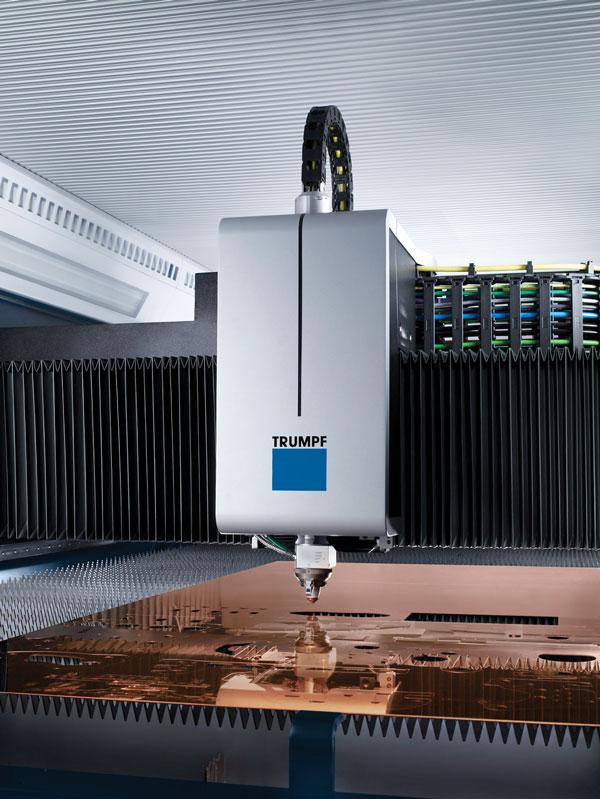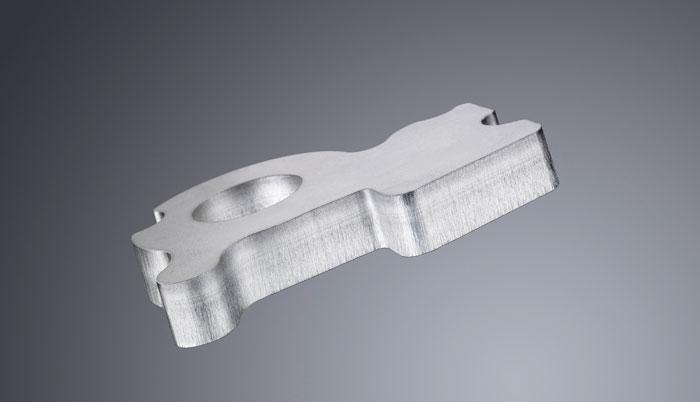- FMA
- The Fabricator
- FABTECH
- Canadian Metalworking
Laser Cutters Through Thick and Thin
Next-generation fiber laser technology enables cutting of both thick and thin materials without operator intervention
- By Joe Thompson
- March 25, 2014
- Article
- Fabricating
That noise you may have heard recently was the sound of new solid-state laser cutting technology making a splash in the marketplace.
A decade ago these laser cutters first began to pop up in shops across North America as unique, one-off manufacturing systems. Today they are available from most of the major laser OEMs, and they look and feel like any other laser cutting system: a cutting head, a bed, and familiar control panels.
These solid-state fiber and disk lasers now account for a major portion of all industrial laser sales—nearly one-quarter according to some reports— making it important to understand the capabilities they can bring to a shop.
Early adopters of this technology already are aware of solid-state lasers’ ability to run at a lower operating cost than CO2 lasers, as well as their reputation for cutting thin material quickly and cutting reflective materials.
The ability to cut both thin and reflective material is a result of kilowatt- level power being delivered to the workpiece material in a small spot size. Beam quality—often referred to as the beam parameter product (BPP)—is defined as how well the beam can be focused. Technically, BPP is a product of the laser beam’s half-angle and the radius of the beam at its narrowest point.
A small, highly focused beam reflects less of the laser’s light back from a reflective surface, making these materials easier to cut. When cutting thin material, this focused beam melts the material quickly, enabling fast head movements to be used.
However, this small spot size also is what has kept these laser systems out of the thick-material cutting market.
“Having a small, concentrated spot is what allows these laser products to excel at cutting thin materials. But when the kerf is very thin, it makes it harder for the oxygen to penetrate the cut, and therefore you have to cut slower,” explained Jason Hillenbrand, laser product manager for Amada America.
Slowing down the cut speed puts more heat into the piece and creates a rougher edge. It also can lead to dross formation as metal welds itself to the bottom of the workpiece.
Laser Flexibility

Cutting reflective material is made possible on solid-state lasers because of the small beam spot size. Photo courtesy of Trumpf.
A new laser cutting system codeveloped by Amada and JDSU now enables the flexibility to cut both thin and thick metals by changing the beam configuration electronically. With previous cutting systems, a condenser lens had to be changed manually to adjust the beam configuration to cut different types of metals.
“The new fiber laser system that we introduced at FABTECH is a nextgeneration system, which eliminates the need to change the cutting lens,” said Hillenbrand. “It allows thin material to be cut at the high speeds people are used to from fiber lasers, and cut thick material at speeds comparable to CO2 lasers and with the quality that they are used to with CO2.”
Fiber lasers historically, albeit with a small sample size, have always been able to cut thick material. The problem areas have always been the speed at which they can cut the material and the quality of the edge.
“When you have a laser with a fixed spot size—whether it’s 50, 70, or 100 microns—whatever that diameter is, that’s basically the BPP factor that you are stuck with. You then have to change the cutting conditions to be able to cut the range of material thicknesses that you want,” said Hillenbrand.
For example, a laser with a 50-micron beam spot diameter will be well-suited to cutting thin materials at high speed, but the maximum material thickness actually will be pretty thin before striations start appearing on the material’s edge. Thicker material can be cut, but the trade-off will be that edge quality is reduced.
With a 70-micron diameter, you will be able to cut thicker material better, but you won’t get the same speed in thinner material.
Traditionally, if the material being cut was between ¾ and 1 in., it was still possible to achieve an edge quality similar to what a CO2 machine achieved, but the material had to be cut at slower speeds and had a little bit more of a taper.
“The end goal always has been to enable the cutting of thin and thick material on one machine with the quality of a CO2 laser, and to do so without interruption by an operator,” said Hillenbrand. “Many shops may not have the luxury of having a 6,000-watt CO2 laser and a 4,000- watt fiber laser. This new technology essentially gives them the flexibility of both of these machines with a 2,000-watt fiber laser.”
New Technology
TRUMPF also recently introduced new technology that enables fabricators to use a solid-state 2-D laser cutting machine to cut a variety of material types and thicknesses, and to switch between thicknesses easily.
“TRUMPF has recently released BrightLine fiber technology that enables shops to cut thin material, reflective material, and even stainless steel up to 1 in. thick with a quality that is equivalent to a CO2 laser,” said Stefan Fickenscher, product manager of the TruLaser Product Group for TRUMPF Inc.
According to Fickenscher, this technology solves the problems caused by the small beam diameter, which produces a thin kerf, by creating a larger spot size when thicker material is being cut.
In addition to improving cut quality and speed in thicker material, this new fiber technology also enables fabricators to produce small holes and execute tight contours in thick sheet metal.
The fully adaptive beam guidance sets the perfect focus in all sheet thicknesses. The switching option in the TruDisk enables a flying change during daily operation between maximum feed rates for thin sheets and best solid-state laser cutting quality with thick sheets.
“Developments like this have made solid-state lasers attractive to many shops, especially those contract fabricators that never know what they will be cutting next. Thick mild steel, stainless steel, and even copper can now all be cut on a single machine,” said Fickenscher. “This flexibility, when combined with high productivity, can give shops a competitive advantage.”
Solid-state lasers are most common in applications that require cutting of nonferrous or reflective metals or processing of thin sheet metal. In these situations, a solid-state laser can produce parts at a rate that a shop may not be used to.
“Shops need their load/unload process to keep pace with the laser’s rate of production,” said Fickenscher. “If the automation cannot keep up, the speed advantage gained by using a solid-state laser is lost.”
Automation
According to Hillenbrand, about 90 percent of fiber lasers Amada sells include an automation system.
“Shops can’t afford to have the machine being idle waiting on an operator to perform the loading and unloading tasks,” said Hillenbrand. “Also, the benefits to productivity that come with automation are lost if you have to stop the machine and perform a lens change when you switch between material thicknesses. This new technology eliminates the need for this change and keeps the laser cutting.”
Adding automation increases productivity, reduces labor, and lowers per-piece costs, sources said, giving North American fabricators the ability to compete with jurisdictions having much lower wages.
“When an automation system is used to handle loading and unloading, an operator can unload parts at the sorting station while the laser is still cutting, increasing this efficiency by up to 30 percent,” said Fickenscher.
Better Laser Processing
According to Fickenscher, the new laser technology also helps fabricators create smaller contours than were previously possible with a solid- state laser.
“You can now cut smaller contours than ever before, and small holes that previously could only be drilled can now be cut with a laser,” said Fickenscher.
This option enables the creation of more complex parts, and it also reduces the cutting time for these parts.
Piercing quality also is improved using multistage piercing, which produces no spatter even when small holes are created.
subscribe now


Keep up to date with the latest news, events, and technology for all things metal from our pair of monthly magazines written specifically for Canadian manufacturers!
Start Your Free Subscription- Trending Articles
- Industry Events
MME Winnipeg
- April 30, 2024
- Winnipeg, ON Canada
CTMA Economic Uncertainty: Helping You Navigate Windsor Seminar
- April 30, 2024
- Windsor, ON Canada
CTMA Economic Uncertainty: Helping You Navigate Kitchener Seminar
- May 2, 2024
- Kitchener, ON Canada
Automate 2024
- May 6 - 9, 2024
- Chicago, IL
ANCA Open House
- May 7 - 8, 2024
- Wixom, MI















